Have you ever wished there was a comfortable alternative to the cone of shame, E-collar? I know my dogs have made that wish. Bailey and Olivia have a drawer full of the hard plastic Elizabethan collars, prescribed to them after various medical procedures. Both girls had a rough time with them and never want to wear one again. It’s the chief reason I decided to review a new product that protects wounds and surgical sites, called Lick Sleeve®. It’s a leg and hip recovery sleeve that was invented by a veterinary surgeon for dogs with orthopedic injuries.
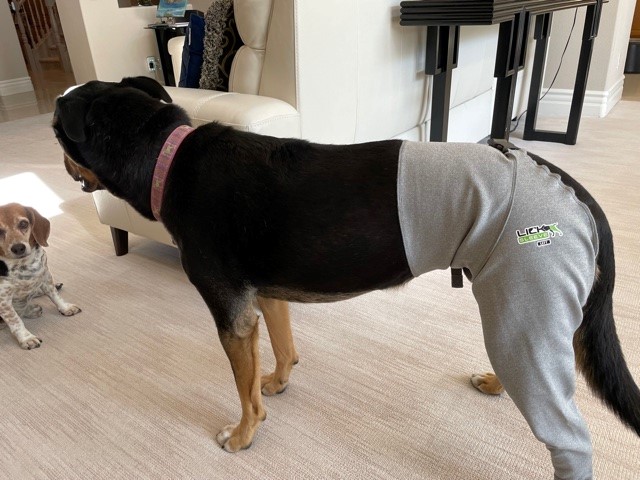
Traditional E-collars block a dog from reaching an injured area by placing a barrier around their neck. The goal is to make it so uncomfortable that a pet will give up trying to lick and scratch a wound or rip open stitches.
Lick Sleeve, on the other hand, protects a wound by covering it up and preventing a dog from touching it. The idea makes sense to me.
(Note: I am not being compensated for this review.)
The Lick Sleeve® story
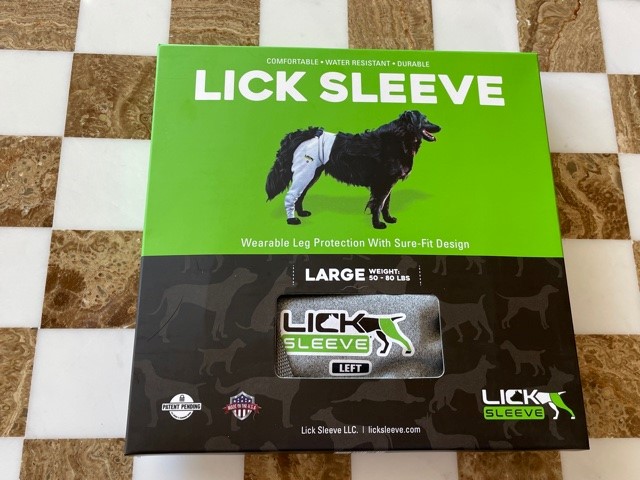
Dr. David Allman is a board-certified veterinary surgeon who specializes in orthopedic surgery in Austin, Texas. He’s the inventor of Lick Sleeve and the founder of Mobile Veterinary Specialist, a group of veterinarians that provide advanced surgical procedures for animals, at the pet’s primary vet hospital.
He realized that a mobile clinic made surgery less stressful for his patients, so instead of making a sick dog travel to a specialty center for treatment, the MVS team goes to where a dog feels more at ease.
The prototype came from an old sweatshirt, but after several design modifications, the Lick Sleeve was born.
How Lick Sleeve works

What you should know about leg injuries in dogs
Canine orthopedic injuries are common, especially in medium to large-breed dogs. There’s a variety of reasons dogs hurt their limbs that range from: cuts, dog bites, bone abnormalities, over-exercise, tumors, and more.
The most common surgery to repair a CCL tear is called Tibial Plateau Leveling Osteotomy (TPLO). It’s a technique that was invented more than 20 years ago and has a good track record for healing dogs.
Pets that have problems recovering from TPLO are typically due to an infection in the wound or activity that was started too soon.
How to put the sleeve on your dog
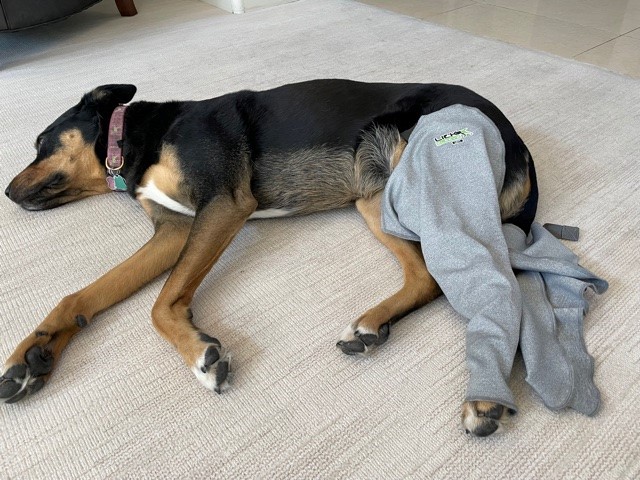
Both the Lick Sleeve box and the website have detailed instructions about how to apply the sleeve, but since they sent a wrap for Bailey to try, I thought I’d share our experience.
Bailey is an 80lb. Rottweiler mix with very long legs. She received an Extra-Large sleeve for dogs weighing 80 – 120lbs. It fit her perfectly.
We started by placing the logo on the outside of her left hip, per the written instructions. Lick Sleeves are fitted for either the left or right rear leg.
I gathered the material and started at Bailey’s paw. Then I pulled the sleeve up to her hip.
Bailey got into a standing position so I could wrap the large flap of the sleeve under her belly and over her back twice. Then I connected and adjusted the buckle into place.
Bailey barely knew the sleeve was there and walked comfortably around the room.
The entire process took less than a minute.
You can find Lick Sleeve on their website.
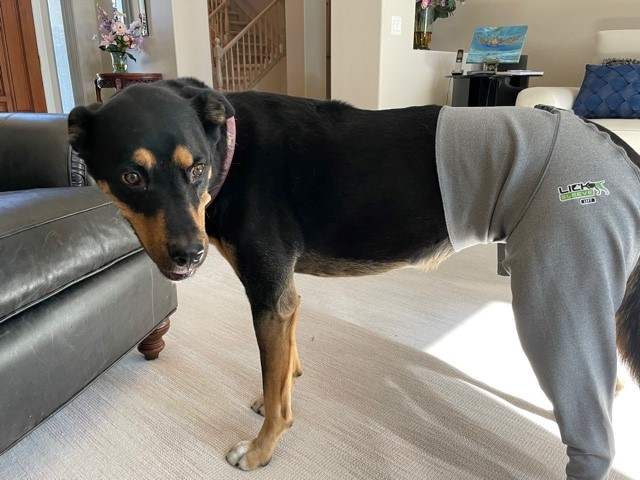

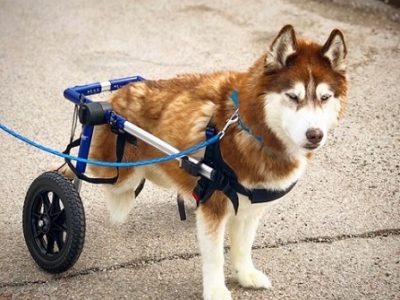



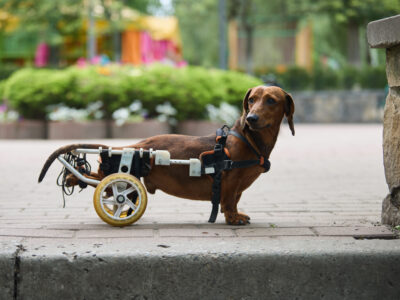
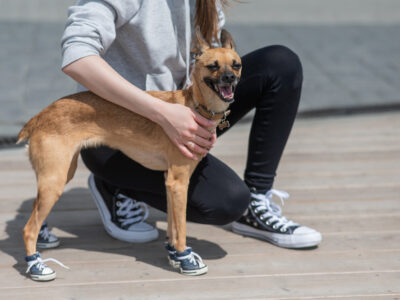

I love this. I hate seeing dogs walking around with a colllar (which I fInd unnecessary anyway if they are out for a walk you are with them and they are not licking a wound). I am curious if these would stay up on a dog that drags. Josie needs leg protection and it’s a constant struggle.
Hi Jennifer. Let Josie know she’s entered in the giveaway. You pose a good question about a dog who drags a paw. The Lick Sleeve Bailey modeled was pretty snug around her ankle. It would have stayed in place no matter how her paw was turned. I also think you could make it fit even more securely with a small piece of Velcro.
My Service Dog and his partner in crime (3-year-old Rottweiler) tore up his Cone of Shame the day after he had surgery!! We had to step out to attend a must-do Visitation and came home to find they’d gotten it off Bwer’s head and shredded it all. over. the. den. Bwer has not bothered his incision though: it’s tended to twice daily and wrapped per the vet’s instructions. His stitches come out Tuesday. He’s a good, sweet boy and I couldn’t live without him.
That’s quite a story! You have 2 very determined dogs.
In October 2019, KC, my 20-pound Chihuahua, had spine surgery and became paralyzed from her waist down. I have spent the past two years trying every product I could find to prevent her from licking her back legs and paws. She can cause great damage and infection if she gets even a few minutes of access to them. I’ve resorted to sewing leggings that attach to a waistband with Velcro. Not a great solution. These look like they might be an answer to our prayers.
Terri, Your dog is entered in the Lick Sleeve giveaway. The sleeve might be a bit large for her, but it sounds like you are good at tailoring. In the meantime, you might want to look at baby onesies to protect your girl’s legs. Good luck! – Sharon
This might work really good for our girl Raven. She scoots on the one side & it seems like it would provide a great barrier for that side.
Vicky, Let Raven know that she’s entered in the giveaway. You may have stumbled on a new purpose for Lick Sleeve. Good luck! – Sharon
Watson would live these!
Hi Kiki, Let Watson know he’s entered in the Lick Sleeve giveaway.
I am entering for my brother’s dog, Pippi. My brother has stage 4 cancer and his dog needs to be spayed. Your lick sleeve would greatly benefit Pippi. Thank you.
Cindie, Pippi is entered in the giveaway. I’m not sure it will help her until she gets spayed as Lick Sleeve is a protective legging, but her name is entered in any case. Good luck. – Sharon
I am entering Amara, not due to locking but for protection for her boney and sensitive legs and knees on the carpet. She is paralyzed and though we have tried drag bags she likes a bit more freedom. As well as protection when in her wheels 🙂
Kelly, Amara is entered in the giveaway. Good luck.
Great idea! Do you make socks as well! My babe Luna self inflicted wound and had to have amputation after her paralysis due to parasthesia. We are protecting other leg and foot at all cost!
Hi Darla, Luna is entered in the giveaway. At this point Lick Sleeve doesn’t make a boot or protective sock, but I bet the sleeve would work wonders for her. Good luck.
-Sharon
I have to dogs who are paralyzed from the waist down. Protecting the legs is really important and the Lick Sleeve might be the answer however one is medium sized (20 pounds) and the other is 11 pounds. Do the come that small?
Hi Rebecca, The smallest size Lick Sleeve is for dogs weighing 30lbs. It might need some tailoring, but I will add your name to the giveaway. – Sharon
We had our first battle with fleas this summer after all the unusual spring & summer rains in West Texas. Unfortunately for our 80 lb Irish Setter Malone, we didn’t realize the invasion until he had developed a terrible case of flea dermatitis.. He developed yeast and bacterial infections and literally chewed off nearly all his beautiful coat. I’ve been training him to be a rehabilitation therapy dog, but I can ‘t take him out in public or even test him until his coat grows back. He is improving, but neither the “cone of shame” nor a bite-not collar keeps him from chewing on his back or hind legs. A lick sleeve looks like it would do the trick.
Pat, You are entered in the giveaway. Good luck. – Sharon
This would be perfect for my paralyzed dog who drags and has quite a twisted body. Where do we buy them
Patty, You can buy lick sleeves at: https://licksleeve.com